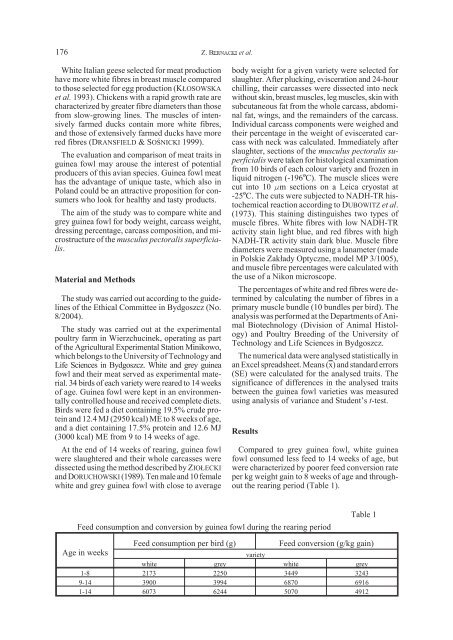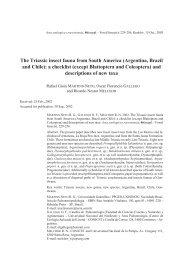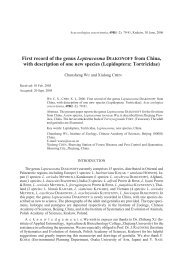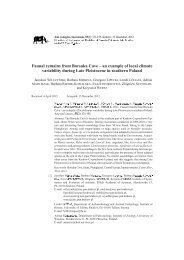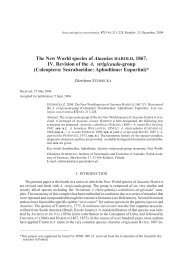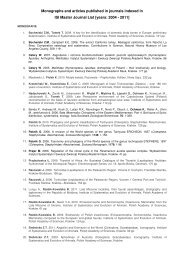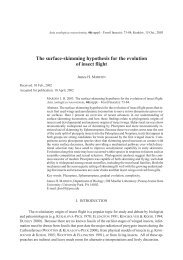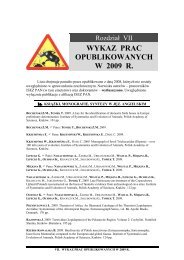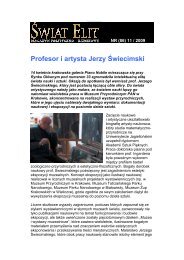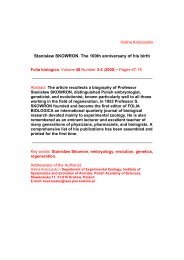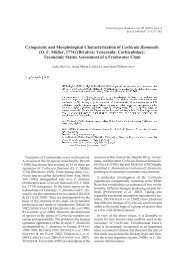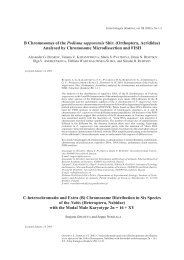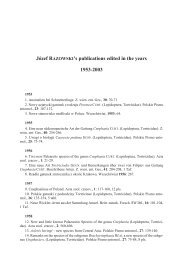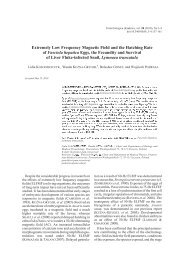Carcass composition and breast muscle microstructure in guinea fowl
Carcass composition and breast muscle microstructure in guinea fowl
Carcass composition and breast muscle microstructure in guinea fowl
You also want an ePaper? Increase the reach of your titles
YUMPU automatically turns print PDFs into web optimized ePapers that Google loves.
176<br />
Z. BERNACKI et al.<br />
White Italian geese selected for meat production<br />
have more white fibres <strong>in</strong> <strong>breast</strong> <strong>muscle</strong> compared<br />
to those selected for egg production (K£OSOWSKA<br />
et al. 1993). Chickens with a rapid growth rate are<br />
characterized by greater fibre diameters than those<br />
from slow-grow<strong>in</strong>g l<strong>in</strong>es. The <strong>muscle</strong>s of <strong>in</strong>tensively<br />
farmed ducks conta<strong>in</strong> more white fibres,<br />
<strong>and</strong> those of extensively farmed ducks have more<br />
red fibres (DRANSFIELD & SOŒNICKI 1999).<br />
The evaluation <strong>and</strong> comparison of meat traits <strong>in</strong><br />
gu<strong>in</strong>ea <strong>fowl</strong> may arouse the <strong>in</strong>terest of potential<br />
producers of this avian species. Gu<strong>in</strong>ea <strong>fowl</strong> meat<br />
has the advantage of unique taste, which also <strong>in</strong><br />
Pol<strong>and</strong> could be an attractive proposition for consumers<br />
who look for healthy <strong>and</strong> tasty products.<br />
The aim of the study was to compare white <strong>and</strong><br />
grey gu<strong>in</strong>ea <strong>fowl</strong> for body weight, carcass weight,<br />
dress<strong>in</strong>g percentage, carcass <strong>composition</strong>, <strong>and</strong> <strong>microstructure</strong><br />
of the musculus pectoralis superficialis.<br />
Material <strong>and</strong> Methods<br />
The study was carried out accord<strong>in</strong>g to the guidel<strong>in</strong>es<br />
of the Ethical Committee <strong>in</strong> Bydgoszcz (No.<br />
8/2004).<br />
The study was carried out at the experimental<br />
poultry farm <strong>in</strong> Wierzchuc<strong>in</strong>ek, operat<strong>in</strong>g as part<br />
of the Agricultural Experimental Station M<strong>in</strong>ikowo,<br />
which belongs to the University of Technology <strong>and</strong><br />
Life Sciences <strong>in</strong> Bydgoszcz. White <strong>and</strong> grey gu<strong>in</strong>ea<br />
<strong>fowl</strong> <strong>and</strong> their meat served as experimental material.<br />
34 birds of each variety were reared to 14 weeks<br />
of age. Gu<strong>in</strong>ea <strong>fowl</strong> were kept <strong>in</strong> an environmentally<br />
controlled house <strong>and</strong> received complete diets.<br />
Birds were fed a diet conta<strong>in</strong><strong>in</strong>g 19.5% crude prote<strong>in</strong><br />
<strong>and</strong> 12.4 MJ (2950 kcal) ME to 8 weeks of age,<br />
<strong>and</strong> a diet conta<strong>in</strong><strong>in</strong>g 17.5% prote<strong>in</strong> <strong>and</strong> 12.6 MJ<br />
(3000 kcal) ME from 9 to 14 weeks of age.<br />
At the end of 14 weeks of rear<strong>in</strong>g, gu<strong>in</strong>ea <strong>fowl</strong><br />
were slaughtered <strong>and</strong> their whole carcasses were<br />
dissected us<strong>in</strong>g the method described by ZIO£ECKI<br />
<strong>and</strong> DORUCHOWSKI (1989). Ten male <strong>and</strong> 10 female<br />
white <strong>and</strong> grey gu<strong>in</strong>ea <strong>fowl</strong> with close to average<br />
body weight for a given variety were selected for<br />
slaughter. After pluck<strong>in</strong>g, evisceration <strong>and</strong> 24-hour<br />
chill<strong>in</strong>g, their carcasses were dissected <strong>in</strong>to neck<br />
without sk<strong>in</strong>, <strong>breast</strong> <strong>muscle</strong>s, leg <strong>muscle</strong>s, sk<strong>in</strong> with<br />
subcutaneous fat from the whole carcass, abdom<strong>in</strong>al<br />
fat, w<strong>in</strong>gs, <strong>and</strong> the rema<strong>in</strong>ders of the carcass.<br />
Individual carcass components were weighed <strong>and</strong><br />
their percentage <strong>in</strong> the weight of eviscerated carcass<br />
with neck was calculated. Immediately after<br />
slaughter, sections of the musculus pectoralis superficialis<br />
were taken for histological exam<strong>in</strong>ation<br />
from 10 birds of each colour variety <strong>and</strong> frozen <strong>in</strong><br />
liquid nitrogen (-196 o C). The <strong>muscle</strong> slices were<br />
cut <strong>in</strong>to 10 m sections on a Leica cryostat at<br />
-25 o C. The cuts were subjected to NADH-TR histochemical<br />
reaction accord<strong>in</strong>g to DUBOWITZ et al.<br />
(1973). This sta<strong>in</strong><strong>in</strong>g dist<strong>in</strong>guishes two types of<br />
<strong>muscle</strong> fibres. White fibres with low NADH-TR<br />
activity sta<strong>in</strong> light blue, <strong>and</strong> red fibres with high<br />
NADH-TR activity sta<strong>in</strong> dark blue. Muscle fibre<br />
diameters were measured us<strong>in</strong>g a lanameter (made<br />
<strong>in</strong> Polskie Zak³ady Optyczne, model MP 3/1005),<br />
<strong>and</strong> <strong>muscle</strong> fibre percentages were calculated with<br />
the use of a Nikon microscope.<br />
The percentages of white <strong>and</strong> red fibres were determ<strong>in</strong>ed<br />
by calculat<strong>in</strong>g the number of fibres <strong>in</strong> a<br />
primary <strong>muscle</strong> bundle (10 bundles per bird). The<br />
analysis was performed at the Departments of Animal<br />
Biotechnology (Division of Animal Histology)<br />
<strong>and</strong> Poultry Breed<strong>in</strong>g of the University of<br />
Technology <strong>and</strong> Life Sciences <strong>in</strong> Bydgoszcz.<br />
The numerical data were analysed statistically <strong>in</strong><br />
an Excel spreadsheet. Means (x) <strong>and</strong> st<strong>and</strong>ard errors<br />
(SE) were calculated for the analysed traits. The<br />
significance of differences <strong>in</strong> the analysed traits<br />
between the gu<strong>in</strong>ea <strong>fowl</strong> varieties was measured<br />
us<strong>in</strong>g analysis of variance <strong>and</strong> Student’s t-test.<br />
Results<br />
Compared to grey gu<strong>in</strong>ea <strong>fowl</strong>, white gu<strong>in</strong>ea<br />
<strong>fowl</strong> consumed less feed to 14 weeks of age, but<br />
were characterized by poorer feed conversion rate<br />
per kg weight ga<strong>in</strong> to 8 weeks of age <strong>and</strong> throughout<br />
the rear<strong>in</strong>g period (Table 1).<br />
Feed consumption <strong>and</strong> conversion by gu<strong>in</strong>ea <strong>fowl</strong> dur<strong>in</strong>g the rear<strong>in</strong>g period<br />
Table 1<br />
Age <strong>in</strong> weeks<br />
Feed consumption per bird (g)<br />
Feed conversion (g/kg ga<strong>in</strong>)<br />
variety<br />
white grey white grey<br />
1-8 2173 2250 3449 3243<br />
9-14 3900 3994 6870 6916<br />
1-14 6073 6244 5070 4912


